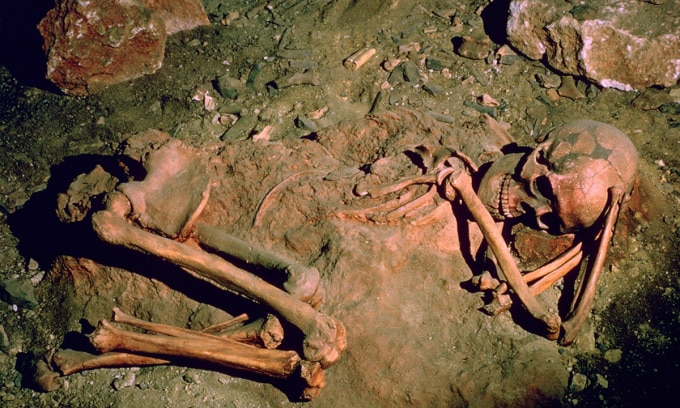
The oldest tombs of modern humans (Homo sapiens), date back to 120.000 years ago, in caves such as Qafzeh Cave, Israel.

Many cultures around the world choose to honor their dead through burial. The rituals that accompany this activity are steeped in history and tradition, and may vary from culture to culture. So when did people first perform burials?
There is no definite answer to this question because not every tomb has been preserved, let alone discovered and studied. However, the oldest evidence to date is from the mid-Paleolithic period (about 300.000 – 30.000 years ago).
At least 120.000 years ago people were buried intentionally, according to Mary Stiner, a professor of anthropology at the University of Arizona. Stiner does not rule out the possibility of more ancient burials, but argues that the most convincing ancient examples of modern humans (Homo sapiens) buried the dead from the middle Paleolithic period. Some studies suggest that extinct human relatives buried their dead about 300.000 years ago, in what is now South Africa, but this remains controversial.
The oldest tombs of modern humans, dating back 120.000 years, are located in caves such as Qafzeh Cave, Israel. There is also evidence of Neanderthal graves in the same cave dating back 115.000 years, according to the Australian Museum. Stiner notes that humans used caves extensively during the mid-Paleolithic period, for eating, living, and socializing.
Many researchers such as Stiner believe that these ancient tombs were intentional human activities, not natural causes (e.g. cave collapse) because the bones were arranged in certain positions (e.g. fetus), in addition to human objects. In some cases, there are even clear traces showing that older sediment was disturbed for burial.
Scientists do not fully understand the origin of burial, but ancient people had many reasons for disposing of bodies both inside and outside of caves. Humans and many animals have an “inherent aversion” to the process of decomposition, according to Trish Biers, manager at the Duckworth Laboratory at the Center for Human Evolutionary Research, University of Cambridge.
People need to find ways to handle bodies when they begin to decompose, smell, and expose living people to flies, pathogens, and scavengers. Initially, burial or other forms of disposal may only be intended to solve the above practical problems, then gradually become more complex.
The progression towards a complex burial does not necessarily happen in a linear manner. A study published in vol The Oxford Handbook of the Archeology of Death and Burial (Oxford University Press, 2013) shows that complex tombs in Eurasia appeared and disappeared at the end of the Paleolithic period (45.000 – 10.000 years ago).
The authors also said that it is difficult to draw firm conclusions about the nature and meaning behind late Paleolithic tombs because scientists have only found a few such tombs. Furthermore, ancient tombs also vary depending on the region.
According to Biers, how people bury their dead depends on many factors, including the environment and available materials. The method of cremation did not come into existence until much later, with the earliest recorded cremation tomb called Mungo Lady in Australia, dating back about 40.000 years.